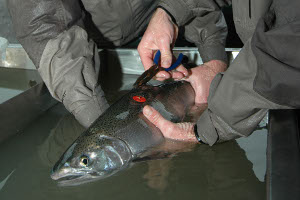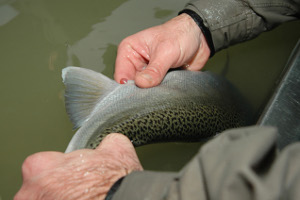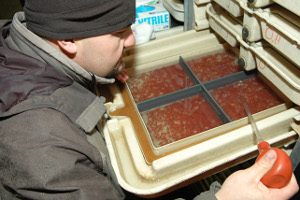 Fisheries technician Wes Hartman (left) and lead biologist Ben White tag a female coho in preparation for spawning at the Warm Springs Hatchery. The tag will help match the female with males that have been selected as mates through genetic screening. Credit: Brandon Beach/U.S. Army Corps of Engineers
Fisheries technician Wes Hartman (left) and lead biologist Ben White tag a female coho in preparation for spawning at the Warm Springs Hatchery. The tag will help match the female with males that have been selected as mates through genetic screening. Credit: Brandon Beach/U.S. Army Corps of Engineers
A short history of California salmon: Glorious past. Grim present. Dark future. Now, the story I just got done working on for QUEST Radio is about the crisis of coho salmon along our coast. But that short synopsis applies as well to coho in other parts of the state and to their larger and perhaps better-known cousins, the chinook. Wherever you look in California, salmon are in serious trouble if they have not already disappeared. It's evident that their biggest problem is having to live alongside us. Our needs and our ability to exert our will on the world around us--to dam rivers and streams, to clear forests, to replace entire ecosystems with new ones of our own making--has wrought havoc on many species.
The collapse of salmon populations is just one example. Some of the people working to preserve and restore coho along our coasts feel that history--both the natural history of the salmon and their role in human history--can be a powerful teacher and could help save the wild fish from extinction.  An egg being squeezed from the vent of a female coho salmon at the Warm Springs Hatchery. Biologists at the facility examine the eggs as part of the process of determining when the females are ready to spawn. Credit: Brandon Beach/U.S. Army Corps of Engineers
An egg being squeezed from the vent of a female coho salmon at the Warm Springs Hatchery. Biologists at the facility examine the eggs as part of the process of determining when the females are ready to spawn. Credit: Brandon Beach/U.S. Army Corps of Engineers  Biologist Rory Taylor checks on a tray of coho salmon recently hatched at the Warms Springs facility. The coho here are called "alevin"--the salmon's earliest life stage. They'll be reared in the hatchery, then planted in tributaries of the Russian River. Credit: Brandon Beach/U.S. Army Corps of Engineers
Biologist Rory Taylor checks on a tray of coho salmon recently hatched at the Warms Springs facility. The coho here are called "alevin"--the salmon's earliest life stage. They'll be reared in the hatchery, then planted in tributaries of the Russian River. Credit: Brandon Beach/U.S. Army Corps of Engineers
Charlotte Ambrose, the National Marine Fisheries Service biologist in charge of coordinating an upcoming recovery plan for coho along our coast, says she has this intertwined history uppermost in her mind. In fact, the draft of the 4-inch-thick recovery plan she's been working on starts with a chapter on the coho's history. Ambrose calls it "a renegade move" to open the document that way, but she says she feels it's crucial to understand the past vitality of coho on the California coast.
She's fond of quoting a 1930s account of a coho run on Northern California's Garcia River: "The water was like glass ... the salmon were in rows ... they lay there still ... every now and then one would wiggle its tail to keep his place in line. They lay there by the thousands as far as my eye could see." That's the glorious past of the coho.
